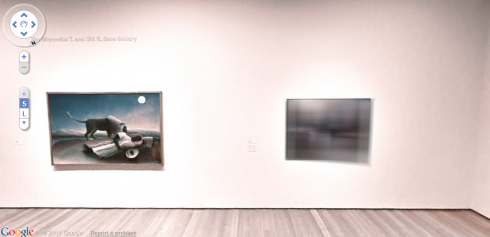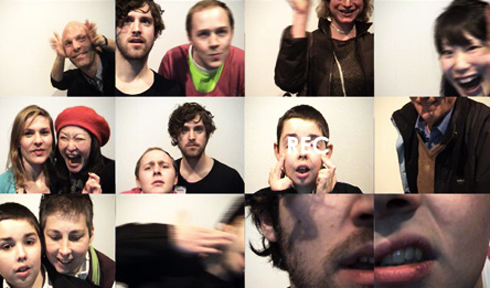Google Art Project uses ‘Street View’ technology, but the street ends where the museum begins. Step over the threshold from Millbank into Tate Britain and you leave the world of pedestrians and traffic behind, entering an eerie and deserted gallery space devoid of fellow visitors or even staff, where crude arrows take you from silent room to silent room. You are invited to respond by conducting a series of imaginary art heists to assemble your own fantasy art collection.
It’s a cliché that modernism privileges visuality, but start exploring the MoMA with Art Project and there are some paintings you literally cannot see; works that due to the exploitability of their image rights elsewhere have been rendered fat with pixels like innocent faces in a cop-stop-action show on Channel 5. They exist, and occupy their rightful space in the museum, that you can be sure of; you are merely not allowed to look at them.
It shouldn’t really be a surprise that this particular vision of the museum as a visually portable feast of pick’n’mix delights is more than eighty years old. In 1930 Frederick Kiesler imagined it like this:
The Telemuseum. Just as operas are now transmitted over the air, so picture galleries will be. From the Louvre to you, from the Prado to you, from everywhere to you. You will enjoy the prerogative of selecting pictures that are compatible with your mood or that meet the demands of any special occasion. Through the dials of your Teleset you will share in the ownership of the world’s greatest art treasures.
This dream of the Telemuseum is realised perfectly by Google Art Project: a device that negates the distance between the remote user and the museum and removes in the process everything but the flat, visual surface of gallery space. Modern painting, historically obsessed with the visual field, canonically displayed in the Modern museum, is teleported to the viewer to experience it in visual purity.
Kiesler’s fantasy is quoted (p59) in Calum Storrie’s The Delirious Museum, a book with a very different approach to the idea of the museum. Storrie begins with the contention that ‘museums should be a continuation of the street’ and that a museum should not only form an accessible part of the city, but also form a continuation of the city itself. In twelve chapters leading from the Louvre to Las Vegas, Storrie develops a history and theory of the ‘delirious museum’ that takes in theft of the Mona Lisa by an Italian nationalist; Benjamin’s Arcades; Marcel Duchamp’s museum-in-a-suitcase; Shwitters’ adventures in personal mythology and museology; Chris Burden’s Samson (a work in which a museum entrance turnstile ratchets timbers outwards, warping and potentially destroying the fabric of the museum itself); Daniel Libeskind’s totemic, increasingly self-referential architecture; and ends (nearly) with the Museum of Jurassic Technology, a Culver City storefront outfit that is at once both oddball Wunderkammer and critique of the idea of memory. This is an underground history of museums that, if you like, runs parallel to the second half of Karsten Schubert’s The Curator’s Egg.
The Delirious Museum is, in art and architecture, all that attempts to broach the classical facades of institutions of art and antiquity and inject something of lived life back into the museological space. Some of these sallies are nakedly political, like the Situationist assault on the spectacle; others are merely concerned with the artistic; once or twice we cross the dreary river of ‘institutional critique’, the gallery’s attempt to reify theory; and three chapters on museum architecture serve only to convince that the yolk of a museum remains infinitely more interesting than the shell. Impossible to realise, the Delirious Museum (like Malraux’s ‘Museum without walls’) is something that can only exist in a book; but it’s a guidebook that also offers us an idea of what we should be demanding from museums.
Storrie goes nowhere near the digital: his delirium remains grounded in the spatial and personal experience of the museum environment. But these tendencies to critique, and more importantly to the expansion of the museum into everyday life are not without their online manifestations. It’s true that net.art remains the great unrealised promise of the internet setting art free, a promise that over-sponsored pixel-pretty shows like Decode fail to redeem. But when with even modest technological means at their disposal museums are capable of opening up photographic archives to the public, teaching science through games, making curatorial processes transparent through blogs and asking the public to contribute to exhibitions years before they open, it seems odd that Google Art Project should feel so like a CD-ROM, the kind of representation of a gallery that those of us who work with museums online for a living had abandoned before the first dotcom bubble even burst. Why has the world’s leading technology company delivered us a ‘virtual museum’ that belongs to the 1930s?

